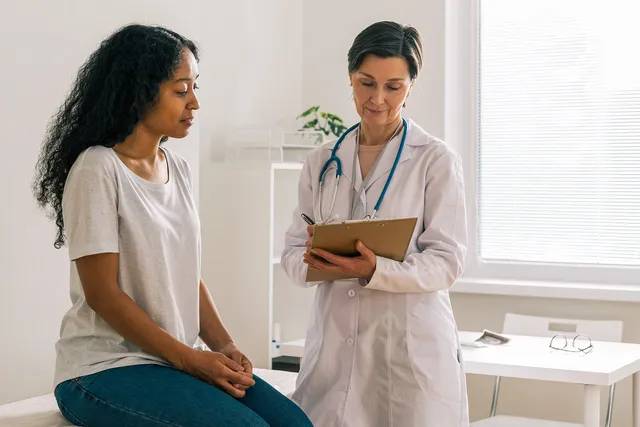May 1, 2024 – Makenna was eager to get an appointment with a gynecologist after moving to a new city and getting what she thought might have been a yeast infection. Makenna, who asked to only be identified by her first name, settled on a male doctor who took her insurance, despite already feeling uncomfortable – as many women often are – with seeing a male gynecologist.
What happened next left her bewildered and traumatized. Makenna, 28, said that during the exam, the doctor put on a pair of gloves, inserted his fingers into her, and then smelled them. After doing this, he told her she had bacterial vaginosis, not a yeast infection. She said there was barely any other dialogue or questions asked before this was done.
She switched to a female gynecologist and didn’t turn back.
Makenna isn’t alone. Many women prefer to see female doctors, for more than just gynecological issues. And studies done over the last several decades have shown that people – especially women – may have better health outcomes if they see a female doctor.
A large study published recently in the Annals of Internal Medicine examined data from 770,000 records of Medicare patients who were hospitalized between 2016 and 2019. Through this analysis, researchers discovered both male and female patients were less likely to die and had lower readmission rates 30 days after leaving the hospital if their care was led by a female doctor; and female patients benefitted significantly more from being seen by a female doctor than male patients did.
While we don’t know exactly why this disparity exists, it likely has a lot to do with a lack of understanding of female pain from the start of medical training, and the life experience that women doctors bring to the table, said Manijeh Berenji, MD, MPH, an assistant professor of environmental and occupational health at the University of California Irvine.
“Every female physician has been a female patient at some point in their lives,” she said. “Sometimes we need more time to process what’s happening and how to articulate it. I try to take the time to parse through that.”
The study, led by researchers from the University of California Los Angeles and the University of Tokyo, found that about 10.15% of men and 8.2% of women died while under the care of a female doctor, compared to 10.23% and 8.4% of patients treated by a male doctor.
Atsushi Miyawaki, MD, PhD, one of the lead authors and an assistant professor of health services research at the University of Tokyo, also has some theories on why these results look the way they do.
“Female physicians may help alleviate embarrassment, discomfort, and sociocultural taboos during sensitive examinations and conversations while examining female patients,” she said.
But even the authors of the study note that, while still statistically significant, the data shows a very slim difference. Berenji said she takes the results with a grain of salt – and wouldn’t be surprised if a lot of her male colleagues do the same.
“We’re seeing more and more of these types of papers coming out, so this is just opening the door further and trying to get to the crux of the issue because there’s clearly a trend here,” she said.
But the results fall in line with a bevy of prior research on this topic. A 2018 study of over 580,000 cardiac patients admitted to Florida emergency rooms also found death rates for men and women were lower when they were seen by a female doctor; women who were treated by male doctors fared the worst. Another study analyzing over 1 million surgical patients, published last year, concluded that patients treated by female surgeons have lower likelihoods of adverse outcomes at 90 days and 1 year after surgery.
This may be due, in large part, to the differences in communication styles seen between male and female doctors. A review of decades’ worth of research has shown that female doctors tend to have longer conversations with patients (on average more than 2 minutes of more face time) than male doctors.
“It was so strange to see how women would respond to me as opposed to my male counterparts. Even spending an extra minute or two really makes a difference, trying to limit the amount of time you spend looking at your computer screen, trying to make direct eye contact,” said Berenji. “I think there needs to be a real fundamental shift in how we assess female patients, especially when it comes to evaluating pain.”
It also makes sense that women tend to have better health outcomes after seeing a female doctor, given the accounts of female patients who have felt that their symptoms were dismissed or not taken seriously enough by male doctors. For instance, in some cases, women visiting ERs had to wait nearly 30% longer than men to be seen by a doctor when they had chest pains, and they were 25% less likely to receive strong pain medications after an ER visit due to sharp belly pains.
Today, more and more women are becoming doctors, with recent estimates showing that they now make up more than half of medical school programs’ student bodies. And the number of female doctors has grown from 28% in 2007 to over 37% in 2021, data shows. Still, that number doesn’t yet reflect the gender demographics of our overall population.
“At the societal level, we need to continue efforts to increase the number of female physicians, which can lead to better outcomes in women’s health,” said Miyawaki.
https://img.lb.wbmdstatic.com/vim/live/webmd/consumer_assets/site_images/article_thumbnails/reference_guide/disparities_in_diagnosis_and_treatment_ref_guide/1800x1200_disparities_in_diagnosis_and_treatment_ref_guide.jpg
2024-05-01 18:11:02





